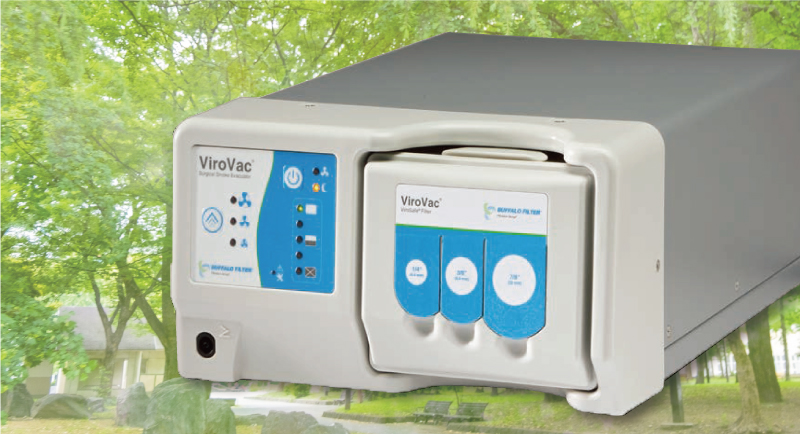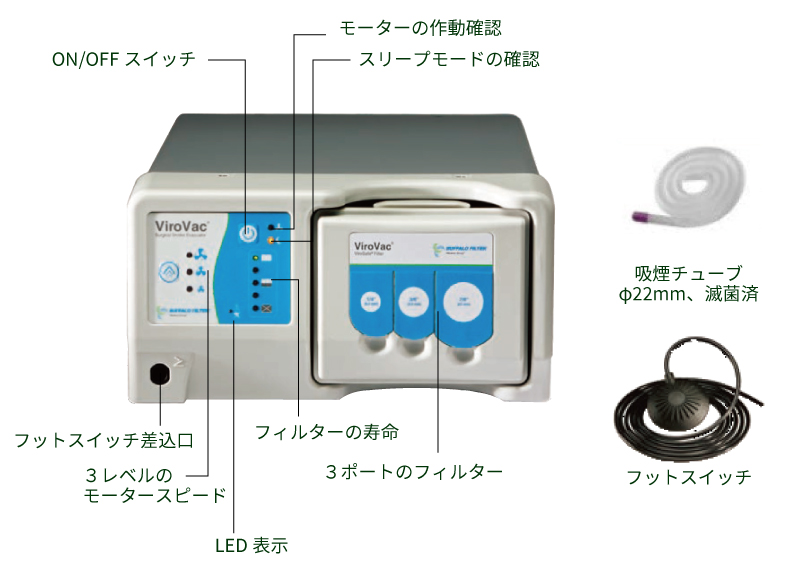【コラム】Recommendation of Smoke Free Surgery「医療者の知られざる健康被害 5分間のモノローグ」
【コラム】Recommendation of Smoke Free Surgery「医療者の知られざる健康被害 5分間のモノローグ」
「笑い」があれば長生きできると、日本医師会前会長の高久史麿先生は、「ユーモア」の大切さを語られています。「笑い」は血糖値や血圧を下げる効果もあるようです。
併せて、一日に一万歩のウォーキング、過食を避け、野菜を多めに摂ることなども健康法に挙げられています。
過度の飲酒や喫煙などは、無論、ご法度。医者の不養生とならないためにも健康に留意しなければなりません。
一方、医療現場で見過ごされているのが、レーザーや電気メスの焼灼時に生成される煙やプリュームの危険性です。
診療時に医師が直面するリスクにつきまとめました。
(出典:株式会社 名優)
Risk - リスク –
化学物質
1),2),3),4)
ベルクロロエチレン、シアン化水素、エチルベンゼン、ホルムアルデヒド、トルエン、一酸化炭素など27種以上の有害化学物質。一酸化炭素に限れば、手術室勤務者は、一日平均27本~30本の喫煙に相当するリスクにさらされているとの報告がある。
感染性微生物
5),6),7),8),9)
生成されるサージカルスモークの95%は水分であり、蒸散された血液や、HIV-1などの感染性ウィルスやバクテリア存在するとの報告がある。
呼吸域物質
10),11),12)
0.01ミクロン以上、200ミクロン未満の粒子。その大部分が0.3~0.5ミクロンの大きさであり、0.3ミクロン以下の粒子は肺胞まで達し、COPD、肺気腫、ぜんそくの増悪などの原因となる。
Bibliography:
1)Health Risk Assessment of VOCs from Surgical Smoke
Shaohua she, Gang Lu, Wah Yang, Mianwei Hong, and Lingfei Zhu; Creative Commons CC; 7/2017
2)The Examination of Problems Experienced by Nurses and Doctors Associated with Exposure to Surgical Smoke and the Necessary Precautions;
Journal of Clinical Nursing; 7/2016.
3)Tackle Toxic Surgery Smoke Risk for Doctors, Nurses, Patients
John Weekes; Stuff.co.nz; 5/2016
4)Study of Health Care Workers Shows Prevalence of Surgical Smoke Exposure
Andrea Steege; Safety and Health Magazine; 11/2015
5)Surgical Smoke and the Dermatologist
Jesse Lewin, Jeremy Brauer, Ariel Ostad; American Academy of Dermatology, Inc., 2010, doi:10.1016/j.jaad, 11.017; 1/2010.
6)Surgical Smoke and Infection Control
E. Alp, D. Bijl; R.P. Bieichrodt; B. hansson; A Voss; Journal of Hospital Infection; 1/2006.
7)BViral Disease Transmitted by Laser-Generated Plume(Aerosol)
Jerome M. Garden, MD; M. Kerry O’Banion, MD; PhD, Abnoeal D. Bakus, PhD; Carl Olson, DVM, PhD; Archives of Dermatology, Vol 13; 10/2002.
8)HPV Positive Tonsillar Cancer in Two Laser Surgeons: Case Reports
Margo Rioux, Andrea Garland, Duncan webster and Edward Reardon; Journal of Otolaryngology, Head and Neck Surgery, 42:54; 1/2013
9)OMaximizing Surgeon Safety During Excimer Laser Photorefractive Procedures
Jay S. Pepose, MD, PhD; American Journal of Ophthalmology, vol 130, No 6; 12/2002.
10)Pilot Study of Directional Airflow and Containment of Airborne Particles in the Size of Mycobacterium Tuberculosis in an Operating Room
Russell N. Olmsted, MPH, CIC; American Journal of Infection Control, Vol 36, No 4; 5/2008.
11)Surgical Smoke and Ultrafine Particles
Irene Brüske-Hohlfeld; Gerhard Preissler; Karl-Walter Jauch; Mike Pitz; Dennis Nowak; Annette Peters; H-Erich Wichmann; Journal of Occupational Medicine and Toxicology; 1/2008
12)Respirable Particles in the Excimer Laser Plume
Michael J. Taravella, MD; EyeWorld, Vol 6, No 6; 6/2001.
1)Health Risk Assessment of VOCs from Surgical Smoke
Shaohua she, Gang Lu, Wah Yang, Mianwei Hong, and Lingfei Zhu; Creative Commons CC; 7/2017
2)The Examination of Problems Experienced by Nurses and Doctors Associated with Exposure to Surgical Smoke and the Necessary Precautions;
Journal of Clinical Nursing; 7/2016.
3)Tackle Toxic Surgery Smoke Risk for Doctors, Nurses, Patients
John Weekes; Stuff.co.nz; 5/2016
4)Study of Health Care Workers Shows Prevalence of Surgical Smoke Exposure
Andrea Steege; Safety and Health Magazine; 11/2015
5)Surgical Smoke and the Dermatologist
Jesse Lewin, Jeremy Brauer, Ariel Ostad; American Academy of Dermatology, Inc., 2010, doi:10.1016/j.jaad, 11.017; 1/2010.
6)Surgical Smoke and Infection Control
E. Alp, D. Bijl; R.P. Bieichrodt; B. hansson; A Voss; Journal of Hospital Infection; 1/2006.
7)BViral Disease Transmitted by Laser-Generated Plume(Aerosol)
Jerome M. Garden, MD; M. Kerry O’Banion, MD; PhD, Abnoeal D. Bakus, PhD; Carl Olson, DVM, PhD; Archives of Dermatology, Vol 13; 10/2002.
8)HPV Positive Tonsillar Cancer in Two Laser Surgeons: Case Reports
Margo Rioux, Andrea Garland, Duncan webster and Edward Reardon; Journal of Otolaryngology, Head and Neck Surgery, 42:54; 1/2013
9)OMaximizing Surgeon Safety During Excimer Laser Photorefractive Procedures
Jay S. Pepose, MD, PhD; American Journal of Ophthalmology, vol 130, No 6; 12/2002.
10)Pilot Study of Directional Airflow and Containment of Airborne Particles in the Size of Mycobacterium Tuberculosis in an Operating Room
Russell N. Olmsted, MPH, CIC; American Journal of Infection Control, Vol 36, No 4; 5/2008.
11)Surgical Smoke and Ultrafine Particles
Irene Brüske-Hohlfeld; Gerhard Preissler; Karl-Walter Jauch; Mike Pitz; Dennis Nowak; Annette Peters; H-Erich Wichmann; Journal of Occupational Medicine and Toxicology; 1/2008
12)Respirable Particles in the Excimer Laser Plume
Michael J. Taravella, MD; EyeWorld, Vol 6, No 6; 6/2001.
日本手術医学会実践ガイドライン
1-4 生体組織の焼灼時に発生する煙霧の毒性を考慮し、患者と手術スタッフが手術中に発生する煙を吸引しないように、排煙システムで屋外に強制的に排気することが望ましい。【解説】電気メスの切開・凝固により、手術野から発生する煙霧は、人体に有害な窒素酸化物を含むため、患者や手術スタッフが煙霧を直接吸うことは望ましいことではない。また、感染疾患患者の煙霧内にウイルスのDNAの存在の危険性も指摘されているが、感染の危険性については、針刺し切創などの血液感染と比べて感染の確率は極めて低いと考えられる。
サージカルスモークの危険性を重視し、レーザーや電気メスの使用時に吸煙器の使用を義務付けてきたデンマーク、スウェーデンに続き、2019年春から米国でもコロラド州、ロードアイランド州でも吸煙器使用が法制化されました。
焼き肉などとは異なる焼灼温度で発生するサージカルスモークを避けようとするのは、当然であり、危険物質が生成され、感染性があることは厳然たる事実です。
サージカルスモークを無臭化するだけでなく、ULPAフィルタを透過させ、完全に無害化する吸煙器こそ、これからの医療現場に必要とされています。
欧米では吸煙器は医療機器として、FDA認証やCEマークが必要なデバイスとなっております。
排出される空気が完全に清浄化され、安心して診療ができる製品をお勧めします。
排煙システム「ヴァイロヴァック」

ヴァイロヴァックは、外科手術におけるエネルギーデバイスにより発生するサージカルスモークを吸引。 術野を見やすくすると共に、不快な臭いを解消し、快適で安全なオペ環境を提供します。
ヴァイロヴァックの特徴
・コンパクトデザイン・ULPAフィルターを含む4層フィルター構造
・最大35時間の長寿命フィルター
・用途に応じた3チューブポート
・シンプルディスプレイによる簡単操作
・静穏設計
ここがオススメPoint! ULPAフィルター
4 層構造のULPA フィルターは、0.12 ミクロンの粒子に対し、99.9995% の濾過効果を実現しています。排煙システム導入の必要性が増してきています
サージカルスモークから患者や医療従事者を守るため、米国手術室看護師協会(Association of perioperative registered nurses: AORN)、国際周術期看護師連盟(International Federation of Perioperative Nurses: IFPN)は、以前より排煙装置の使用を推奨してきた。既にデンマークや米国カリフォルニア州などでは排煙装置の設置が義務化されている。排煙装置は、吸引デバイス、吸引システム、濾過装置から構成され、吸引システムは吸引力30〜40m/minを推奨している。濾過装置には、空気清浄機やクリーンルームのメインフィルタとして用いられ、0.10μmの粒子を99.9995%以上捕捉するULPA(Ultra Low Penetration Air Filter)規格の超高性能フィルタが用いられている。出典:日本外科教育研究会「Surgical Smoke in the Era of COVID-19新型コロナウイルス感染症とサージカルスモーク(ver 1.2 released 4/22/2020)」
http://www.surgicaleducation.jp/surgicalsmoke.html
システム
ヴァイロ・ヴァック排煙システム品番:VV120
価格:¥396,550(税抜価格¥360,500)
入数:1組
同梱物:本体/フットスイッチ/フィルター/チューブ2本/
ヴァイロ・ヴァック用ヴァイロセーフフィルター
品番:VS353
価格:¥67,980(税抜価格¥61,800)
入数:1個
吸煙チューブ
品番:VTWT424X3
価格:¥11,963(税抜価格¥10,875)
入数:3本
規格:直径22mm、全長1.8m、滅菌済

形状・仕様
サイズ:W279×D394×H152 mm重量:5.0kg
流量:25cfm(708lpm)※22mmチューブ使用時
騒音レベル:最大55dB
医薬品、医療機器等の品質、有効性及び安全性の確保等に関する法律に基づく表示
医療機器届出番号13B1X10241001036 一般医療機器(チューブ)本体・フィルター類は、医薬品医療機器等法非対象品
各国のサージカルスモークに関する基準について
Association of periOperative Registered Nurses(AORN)
Regulations, Recommended Practices Standards – Occupational Safety Health Administration(OSHA)OSHA is the only U.S. regulatory body to date that has legal auhority in the United States granted by Congress. They estimate that 500,000 healthcare workers are exposed to surgical smoke and bio-aerosols each year. On a number of occasions OSHA has reiterated that the management of surgery plume is a healthcare worker safety issue.
Association of periOperative Registered Nurses(AORN)
AORN is a professional association based in Denver, Colorado that represents the interests of more than 160,000 perioperative nurses. The following are contained in Recommended Practices:
2017 AORN Guideline for Surgical Smoke Safety
■ Recommendation Ⅰ
“The health care organization should provide a surgical smoke free environment.”
■ Recommendation Ⅱ
The perioperative team should evacuate all surgical smoke. “The collective evidence, standards, and guidelines from NIOSH, the Healthcare Infection Control Practices Advisory Committee, and professional organizations indicates that evacuating surgical smoke protects patients and health care workers from the hazards of surgical smoke.”
■ Recommendation Ⅲ
“Perioperative team members should receive initial and ongoing education and competency verification on surgical smoke safety.”
■ Recommendation Ⅳ
“Policies and procedures for surgical smoke safety should be developed, reviewed periodically, revised as necessary, and readily available in the practice setting in which they are used.”
■ Recommendation Ⅴ
“Perioperative personnel should participate in a variety of quality assurance and performance activities that are consistent with the health care organization’s plan to improve understanding and compliance with the principles and processes of surgical smoke safety.”
2017 Guidelines for Perioperative Practice, First Published: December 2016. CCopylight © 2017 AORN, Inc. All rights resAssociation of periOperative Registered Nurses(AORN)
NIOSH Hazard Controls HC11 – CDC
国立労働安全衛生研究所による、有害物質が確認されているので除去すべきとの勧告。(National INstitute of Occupational Safety and Health, NIOSH)HAZARD
During surgical procedures using a laser or electrosurgical unit, the thermal destruction of tissue creates a smoke byproduct. Research studies have confirmed that this smoke plume can contain toxic gases and vapors such as benzene, hydrogen cyanide, and formaldehyde, bioaerosols, dead and live cellular material (including blood fragments), and viruses. At high concentrations the smoke causes ocular and upper respiratory tract irritation in health care personnel, and creates visual problems for the surgeon. The smoke has unpleasant odors and has been shown to have mutagenic potential.
サージカルスモークやプリュームにはベンゼンやシアン化水素などの有毒ガスや蒸気が含まれ、血液片などの細胞物質やウィルスが存在することが調査研究で確認されている。
CONTROLS
NIOSH research has shown airborne contaminants generated by these surgical devices can be effectively controlled. Two methods of control are recommended:
NIOSHの研究で手術機器により生成された空中浮遊汚染物質は効果的に制御できることが明らかになっている。二つの制御法が推奨される。
VENTILATION
Recommended ventilation techniques include a combination of general room and local exhaust ventilation (LEV). General room ventilation is not by itself sufficient to capture contaminants generated at the source. The two major LEV approaches used to reduce surgical smoke levels for health care personnel are portable smoke evacuators and room suction systems.
医療現場での主な換気法とは、医療者へのサージカルスモークの暴露レベルを減らすための方法であり、移動可能な吸煙器、室内の排気システムの二つである。
Smoke evacuators contain a suction unit (vacuum pump), filter, hose, and an inlet nozzle. The smoke evacuator should have high efficiency in airborne particle reduction and should be used in accordance with the manufacturer’s recommendations to achieve maximum efficiency. A capture velocity of about 100 to 150 feet per minute at the inlet nozzle is generally recommended. It is also important to choose a filter that is effective in collecting the contaminants. A High Efficiency Particulate Air (HEPA) filter or equivalent is recommended for trapping particulates. Various filtering and cleaning processes also exist which remove or inactivate airborne gases and vapors. The various filters and absorbers used in smoke evacuators require monitoring and replacement on a regular basis and are considered a possible biohazard requiring proper disposal.
Room suction systems can pull at a much lower rate and were designed primarily to capture liquids rather than particulate or gases. If these systems are used to capture generated smoke, users must install appropriate filters in the line, insure that the line is cleared, and that filters are disposed properly. Generally speaking, the use of smoke evacuators are more effective than room suction systems to control the generated smoke from nonendoscopic laser/electric surgical procedures.
一般的に、非内視鏡的なレーザーや電気メス手術で生成される煙を制御するのには、室内の排気システムよりも、吸煙器を使う方が、より効果的といえる。
Australian College of Operating Room Nurses(ACORN) Standard S20
・Personnel shall utilize appropriate equipment and procedures to prevent exposure to surgical plume・Exposure to surgical plume shall be minimized during the surgical procedure
・Surgical smoke capture devices shall be available for use during procedures in which surgical smoke is generated(ACORN 2006)
Canadian Standards Association(CSA)
CSA Z305.13-13 Plume Scavenging in Surgical, Diagnostic, Therapeutic, and Aesthetic Settings.・Facility policies and procedures shall be written in accordance with (IAW) this Standard.
・Plume shall be evacuated IAW this standard.
・If a facility employs techniques that create plume, they shall have policies that address the potential hazards.
Danish Working Environment Authority
At-Instructions 4/2007 and 11/2008・It is mandatory to implement a measurable setup for local evacuation of harmful substances, such as surgical smoke.
・Such a setup must be equipped with a monitoring feature to indicate if the evacuation system’s suction is inadequate.
・Surgical smoke should be removed with local evacuation and as close to the source as possible.
・The filtered air must lead out into the open (read: outside the OR)
Medicines and Healthcare Products Regulatory Agency(MHRA)
MHRA DB2008(03) April 2008・Recommends that smoke evacuation systems are to be used during laser surgery. In addition, it is specified that masks and operating room laminar flow systems are not suitable for protection from surgical smoke.
Association for Perioperative Practice(AfPP)
Standard 2.6 Lasers – Standards and Recommendations for Safe Perioperative Practice・States that ‘Dedicated smoke evacuation machines must be used to remove the smoke…’ (AfPP 2007). AT-Instructions 4/2007 and 11/2008
・It is mandatory to implement a measurable setup for local evacuation of harmful substances, such as surgical smoke.


